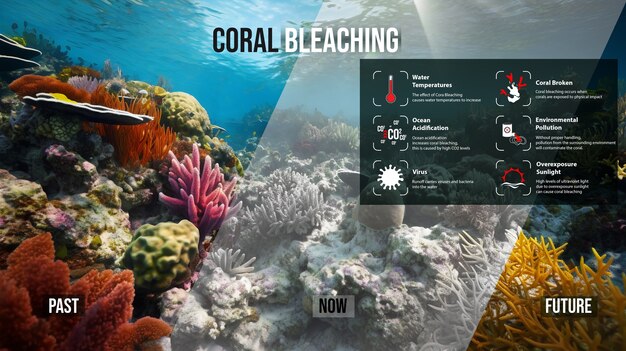

Coral reefs are the rainforests of the ocean, teeming with diverse marine life.
The Great Barrier Reef is the largest coral reef system in the world, spanning over 2,300 kilometers.
Coral reefs are formed by the accumulation of calcium carbonate skeletons of coral polyps.
Reefs provide a vital ecosystem for countless species, providing food, shelter, and breeding grounds.
Coral reefs are often referred to as the Underwater Cities due to their bustling and interconnected communities.
Some corals can live for hundreds of years, forming magnificent structures over time.
Reefs also act as natural barriers, protecting coastlines from erosion and storm damage.
Coral reefs are incredibly sensitive to changes in water conditions, making them a canary in the coal mine for ocean health.
The colors of coral reefs come from the symbiotic relationship between coral and microscopic algae called zooxanthellae.
One of the largest threats to coral reefs is coral bleaching, caused by rising ocean temperatures.
Coral reefs are found in tropical and subtropical waters around the world, from the Red Sea to the Caribbean.
Some species of coral can glow in the dark, creating stunning displays at night.
Coral reefs are a popular tourist attraction, drawing millions of visitors every year to snorkel and dive.
Corals are not plants but are actually tiny animals related to jellyfish and sea anemones.
Coral reefs are known for their stunning biodiversity, housing approximately 25% of all marine species.
Coral reef fisheries provide livelihoods and sustenance for millions of people around the world.
Despite covering only 0.2% of the ocean floor, coral reefs support around 25% of all marine species.
Reefs are a mecca for photographers, with vibrant colors and intricate patterns creating stunning compositions.
Coral reefs play a crucial role in carbon cycling, helping mitigate climate change by removing carbon dioxide from the atmosphere.
Some coral reefs can be heard singing due to the cacophony of noises produced by their inhabitants.
Reefs are not only home to fish; they also provide essential habitat for numerous species of sharks, rays, and turtles.
Coral reefs are an excellent example of nature’s architectural wonders, with intricate structures and designs.
Some corals have medicinal properties, with compounds derived from them showing potential in cancer treatments.
Reefs are constantly growing, with new coral colonies forming on top of older ones as they expand.
Coral reefs are nicknamed the Rainforests of the Sea due to the incredible biodiversity found within them.
Reefs can be found at various depths, from shallow waters near the surface to deep-sea habitats.
Coral reefs are home to approximately 800 species of reef-building corals.
Reefs are facing immense challenges from pollution, overfishing, and ocean acidification due to climate change.
Some coral reefs are protected as marine parks and reserves, offering sanctuary to fragile ecosystems.
Coral reefs provide an essential food source for over one billion people worldwide.
Coral reefs have inspired countless works of art, from paintings to sculptures, due to their beauty and fragility.
The majority of the world’s coral reefs are still largely unexplored, with many discoveries waiting to be made.
Coral reefs create a natural nursery for fish and other marine organisms, supporting the health of the entire ocean.
Some species of coral can change their colors as a response to environmental factors such as temperature or light.
Coral reefs have been around for millions of years, with some fossilized reefs dating back 500 million years.
Coral reefs are a source of wonder and awe, captivating divers and snorkelers with their vibrant colors and abundant life.
The destruction of coral reefs not only harms marine life but also affects the livelihoods of millions of people who depend on them.
Some countries rely heavily on tourism revenue generated by coral reefs, making their preservation crucial for their economies.
Coral reefs are home to unique and extraordinary species, many of which are found nowhere else on Earth.
The intricate shapes and textures of coral reefs provide inspiration for architects and designers in various fields.
Reefs are like underwater cities, with different neighborhoods occupied by different species depending on their ecological needs.
Coral reefs are valuable indicators of the health of the ocean, offering insight into the impacts of climate change and pollution.
Reefs are excellent biodiversity hotspots, showcasing the interconnectedness of ecosystems and the importance of protection.
Reefs have been described as the underwater equivalent of tropical rainforests, due to their immense biological richness.
Discovering the beauty of coral reefs is like stepping into another world, reminding us of the wonders and fragility of our oceans.
Around the world, coffee enthusiasts enjoy Monin coffee concentrate since it is a multipurpose product. Conveniently combining…
The Importance of Choosing the Right Shower for Your Bathroom Renovating your bathroom can be…
Usain Bolt holds the record for the fastest 100-meter sprint in history.Bolt was named Sportsman…
Love is in the air... and it smells suspiciously like chocolate!Roses are red, violets are…
Life's a beach, take a picture and relax.Sun, sand, and salty kisses. That's what beach…
Hungary is home to the largest thermal water cave system in the world.The Rubik's Cube…